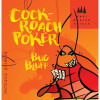- Learning time
- 20 minutes
- First play time
- 40 minutes
Cockroach Poker
Designed by: Jacques Zeimet
In Cockroach Poker (also known as Kakerlaken Poker) each player is trying to avoid collecting a set of insects. It’s relation to poker is not in the mechanics of the game, but the fact it’s all about two things: bluffing, and reading people.
The game comes as a deck of 64 cards, made up of 8 suits of 8 pests. These are shuffled, and dealt out to the players. A random player is chosen to start. That player chooses a card from their hand and passes it face-down to another player of their choice, announcing what it is as they do so. The key thing here is the announcement. As active player you can choose to tell the truth: “This is a rat” or to lie: “This is a cockroach”.
The receiving player has two choices. They can announce whether they think you are lying or not, and turn the card over. If they guess correctly, the card is returned to you and placed face-up in front of you on the table: the start of an unwanted set. If they guess incorrectly, they have to put the card face-up in front of themselves.
The second choice is to look at the card. Having done so, they are now the active player and must pass the card on to a third player, choosing whether or not to tell the truth or lie. Now the third player faces the same choices: to call (i.e. say whether they think it’s truth or lies) or look at the card, and pass it on to someone else. This sequence only ends when the card is flipped – and that gets forced when the last player playing receives the card, and has no-one to pass it onto.
What begins as a slightly nutty game increases in tension as people collect more cards in front of them, and have fewer options in their hand. If, for instance, close to the end of the game, there are 7 rats visible on the table, everyone knows there is only one more rat hidden, so there is a huge risk in bluffing you have a rat if you don’t – but simultaneously, there is a risk in passing someone a rat and telling them the truth. The balance of the game lies in both the closing off of options as cards run out, and the performance: just how good are you at lying – and pretending to lie?
The guru's verdict

-
Take That!
Take That!
Younger or more sensitive players could end up feeling victimized as the game is about constantly trying to fool people, or challenge them.
-
Fidget Factor!
Fidget Factor!
None. You're always on tenterhooks.
-
Brain Burn!
Brain Burn!
Argh! There's only ever two options, challenge or look at the card.
-
Again Again!
Again Again!
Best played with several players, though the game itself can be played with two, it's impossible to play the same way twice.













Sam says
Kakerlaken is all about reading people. You don't need luck, strategy or tactics. You just need a little bit of chutzpah and the ability to see through lies - or recognise truth. Great game.